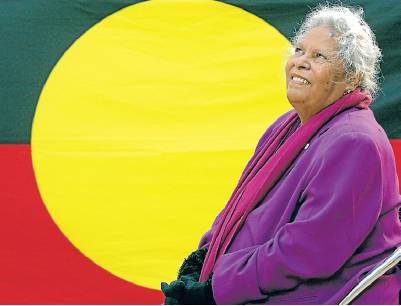Fearless writer revealed the lives behind the Sorry Day stories of dispossession
DORIS PILKINGTON GARIMARA
Writer 1937 – 10-4-2014
‘I took my children to walk on my hot, dusty land. It was then that I was reunited with my mother.’
Sometime in 1937, Doris Pilkington Garimara was born Nugi Garimara under a wintamarra – mulga – tree on Balfour Downs Station, the daughter of Molly Craig and Toby Kelly, an Aboriginal stockman. Six years earlier, in 1931, Molly had escaped from Moore River Native Settlement with her two sister/ cousins, Daisy and Gracie, and walked all the way back to Jigalong, an extraordinary journey along the rabbit-proof fence that took them three months.
When Doris was 4, she, her mother and Annabelle, her new little sister, again came to the attention of Auber Octavius Neville, the chief protector of Aboriginals in Western Australia. They were interned at Moore River. Molly ran away, taking the baby with her but leaving Doris behind. She did not see her mother again for 21 years.
Pilkington grew up at Moore River and at 12 was transferred to Roelands Mission where missionaries brought her up to believe Aboriginal people were dirty and evil. ‘‘I actually despised my own traditional culture because we were taught to,’’ she said. ‘‘We were told that our culture was evil and those that practised it were devil worshippers. I was taught to deny my own people – be ashamed of them even. The blacker your skin was, the worse individual you were.’’
But an aunt at Moore River had told her: ‘‘Don’t forget who you are. Your mother’s name is Molly Craig and you come from Balfour Downs.’’
In 1962, Pilkington set off in search of her mother. ‘‘I took the journey back to my land at Jigalong in Western Australia,’’ she wrote. ‘‘I took my children to walk on my hot, dusty land. It was then that I was reunited with my mother.’’
Pilkington was a storyteller. One of the necessary characteristics of a storyteller is to recognise a good story when you hear one. And Pilkington knew when she heard the story of her mother’s flight from Moore River Native Settlement and her journey back home following the rabbit-proof fence, that this was a great story. “Aunt Daisy told me her memories,” she said, ‘‘and as soon as she finished talking, I wrote it down and vowed to fill in the missing pieces later on.”
She approached a publisher with an outline of the story. They replied encouragingly, suggesting that she write it in a narrative form. Pilkington put the story to one side and wrote her first narrative book Caprice, A Stockman’s Daughter. It won the David Unaipon Award and was picked up by Queensland University Press. Now a published writer, she set about ‘‘filling in the missing pieces’’.
Follow the Rabbit-Proof Fence was published in 1996. It has been translated into 11 languages and made into the film Rabbit-Proof Fence. Pilkington and I worked together in developing the script for the movie. She would take me to Jigalong to stay with her mother and we would sit yarning with all and sundry on Molly’s verandah.
On one of our trips to Jigalong, a cyclone threatened. If the river came up, we could be caught there for up to three weeks. Ed, Pilkington’s partner (Pilkington was the surname of her first husband), was determined to get us out before that cyclone struck. He was a Fremantle Dockers fan and there was a footy match at stake. First, we drove out by the main dirt road. It took us an hour to get to the first ford. Too late, the river had already risen and we couldn’t get across.
Undeterred we turned back, filled the car with petrol at Jigalong and set off ‘‘the back way’’. It was hardly even a track. After three hours we hit the edge of the cyclone – teeming rain and nil visibility. We stopped. In all of this Pilkington had said nothing. There were four of us in the car, Pilkington, her partner, me and my 11-year-old, Harry. We did not know where we were nor how bad the storm was going to get. In the morning, we were surrounded by water, lapping at the bottom of the car doors. Pilkington now spoke. ‘‘This is what you get when you are impatient.’’ Eventually the water began to drop and we spent another night there. Pilkington did not complain once. It became another of her stories.
In 2002, Pilkington was appointed co-patron of the Sorry Day/ Journey of Healing. The following year, QUP published Under the Wintamarra Tree, the third in her trilogy.
In 2008, she received the Red Ochre Award, given to an indigenous artist for their outstanding contribution to Aboriginal and Torres Strait Islander arts.
One of Pilkington’s favourite stories was of her own birth under the Wintamarra tree. Years later she returned to the spot with her mother. ‘‘So we went together and sat under this tree and that was the most spiritual event in both our lives, that mother and daughter had gone back to this very spot that the premature daughter was born and given a week to live. Yet that little baby there said, ‘No way’.’’
Doris Pilkington was utterly honest and fearless. She said that her great regret was ‘‘to accuse my mother of giving me away and putting me in a home. The Sorry Day stories you hear are of people telling these stories and how it affected them.’’
Doris is survived by her children Maria, Albert (Sonny), Gerard (Jock) and Richard (Ricky), 31 grandchildren and 80 greatgrandchildren.
